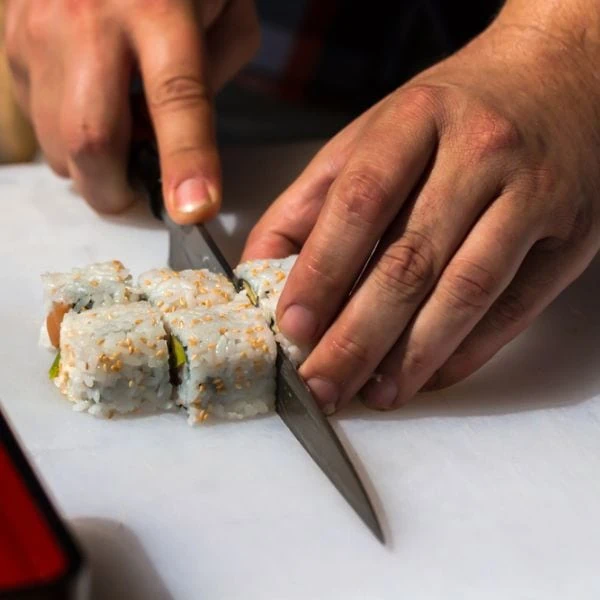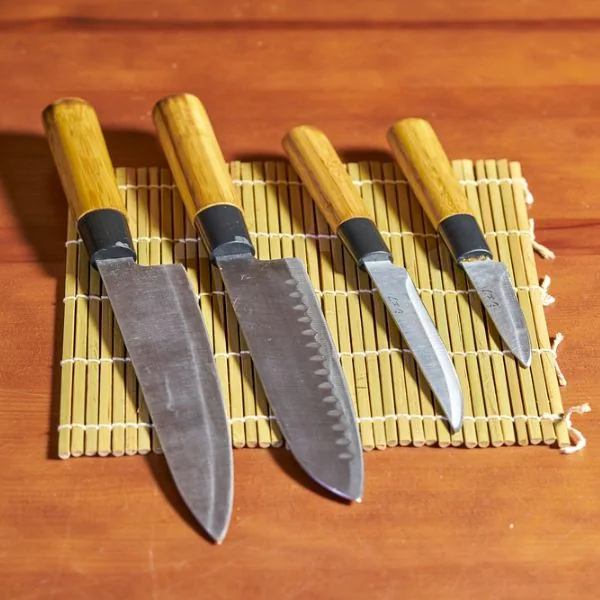If you have friends that make sushi and ask them ‘What’s the best sushi knife for beginners?’, then you’ll probably get a confusingly large number of answers. Your friends can’t help it – Sushi making is an art and they’re just excited but don’t worry too much about it because we’ve got you covered.
In today’s article, we’re going to give you a crash course in sushi knives, so that you’ll know which knives are essential, and what they do, and we’ll also provide you with examples of some of our favorites. After that, we’ll give you some beginner tips to get you started and a few rules for when you’re buying your own knives.
By the time we’re done, you’ll have exactly what you need to get started! So, what’s the best sushi knife for beginners?
Read on and see!
Do you really need sushi knives to make sushi?

Over time, our ‘kitchen collection’ can become rather substantial, and if this is the case with your own then you might be wondering ‘Do I really need sushi knives to make sushi?’. Well, theoretically, we’d have to say that the answer would be ‘no’ – provided that you didn’t mind some serious workarounds.
Even then, something would seem amiss, and rightfully so. You see, the Hocho, or ‘kitchen knife’ is not considered so ‘common’ a thing in Japan, but rather like an artist’s paintbrush.
Don’t get us wrong – the Japanese Hocho is still about cutting – but it’s also like a performance art. You have certain knives that are so sharp, that they effortlessly part meats and vegetables while you prepare them, which in turn makes them more delicious – they weren’t crushed or pulled apart, you see, but divided with laser precision.
This precision also helps to ensure that natural juices are retained and even the shapes and consistencies of food are at the command of the chef’s skillful knife.
To give you an idea of the history behind it, the oldest set of kitchen knives in Japan are kept in the Todaiji temple in Nara and they date back as far as the 8th century!
While those Hocho look rather like miniature Japanese swords, as the centuries progressed, they would begin to take the shapes that are more familiar to us in the modern day. Sushi knives are a great example of this – each has a specialized purpose and when used together, they allow you to manipulate vegetables, fish, and seaweed in such a way that flavors are preserved and blended and each piece of the meal has been carefully crafted.
So, while you could theoretically make something approximating sushi, something will be missing if you don’t do it right. Let’s look at the types of sushi knives and we’ll explain to you what each is intended for so that you’ll have a better idea of the longstanding tradition and intent behind these blades.
The essentials

While there are many types of sushi knives, there are 4 knives in particular that are considered to be essential for proper preparation. We’ll tell you a little about each in the sections to follow:
- Yanagiba knife
- Deba Knife
- Usuba Knife
- Santoku Knife
Yanagiba knife
The Yanagiba (willow-shaped) knife is slightly thicker than your average western blade and has a single bevel on it, as well as a slight curve at the other side which helps to keep food from sticking. The long Yanagiba is designed for fileting small and medium-sized fish and may also be employed in skinning them, and the razor sharpness of that single bevel allows you to do so almost effortlessly!
Deba Knife
Another single-beveled beauty is the Deba knife, which is a powerful and weighty blade that often features a thickened spine, allowing you to butcher, filet, or otherwise slice into fish and poultry alike. You’ll end up with a few Debas, eventually, as each one is especially suited for specific types of meat!
The name itself translates roughly into ‘pointed carving knife’.
Usuba Knife
Your Usuba is your veggie knife and the name itself means ‘thin slice’ – and that’s exactly what it does. An Usuba blade has a single bevel and it allows you to peel vegetables or slice them thin enough that you could make transparent windows for a veggie house if you liked!
What’s really special about the knives, though, is that the cutting is so precise, that very little cellular damage is done when you cut the veggies. This means that more of the natural color and taste is retained, which is amazing to think about and even better to taste!
Santoku Knife
Finally, our last essential knife is the humble Santoku and its name means ‘3 virtues’. It’s a poetic description of its purpose, really, as the 3 virtues that the Santoku can manipulate are meat, fish, and vegetables!
The design of the knife itself is a little bit flatter so that you can get a comfortable rhythm with slicing that you would with any other knife.
Other sushi knives
While we can’t go over all of the types of sushi knives in the space that we have today, here are a couple more that you’ll run into and likely add to your collection quickly.
Gyuto Knife
The Gyuto or ‘chef’s knife’ is an all-purpose knife for the kitchen that features a double bevel and differs from its American and European cousins in that the blade is a little thinner and the steel is much harder.
Nakiri knife
The Nakiri is a type of Usuba knife that features a Westernized double-bevel, rather than a single one. Like the Usuba, it’s for cutting vegetables, although it’s more about chopping, dicing, and mincing than the more decorative things that the Usuba can do.
If we had to quantify the difference, it’s easiest to say that a Nakiri can produce some artfully cut veggies, but with an Usuba you could practically whittle tiny faces on them!
The best sushi knife for beginners
In this section, we’re going to provide an assortment of choices, so that you have some medium-level and budget-grade options to get you started with.
Keep in mind that we want to provide a diverse selection, but we’re avoiding going ‘overboard’ since you are just getting started. There is definitely a lot of very high-end sushi cutlery out there that will set you back an arm and a leg, but you don’t want to take that leap until you’ve gotten a little experience under your belt.
That said, all of the blades here are great options to start with which will serve you well until you’re ready to start upgrading and we guarantee that with some of these, you might not even want to upgrade at all!
Let’s take a look now at the best sushi knives for beginners!
Kai Wasabi Black Yanagiba Knife, 8 1/4″
This Kai black Yanagiba is a fantastic knife for the precision cutting that you need with your fish slices, sushi rolls, and sashimi. The company that makes these is established in Seki City, Japan, and the blade itself is corrosive-resistant, high-carbon stainless steel. Add in that it has a d-shaped, polypropylene handle blended with bamboo powder for an excellent grip and precision control and you’ve got a knife that you’ll be getting good use out of for many years to come.
Mercer Deba knife – 6″
Next up we have a robust little Deba knife that comes from the Mercer Culinary Asian Collection and it’s a nice little knife to have. This 6” Deba is made of high-carbon German steel and comes with either a wooden or a no-slip santoprene handle, depending on which you prefer.
While competitively priced, if you take a look at the reviews you’ll notice that these Debas are getting quite a lot of praise, with some customers advising that they slice through just about anything like butter and arrive razor-sharp, right out of the box! If you like the idea of a Japanese-style blade made of stout German steel, then this Mercer is the right knife for you!
Tradafor Usuba knife – 7″
Tradafor is the brand for our next entry and they produce a fine traditional Usaba knife for right-handed sushi aficionados out there. We should point out, if you are left-handed, then you will want to find a left-handed Usaba – these blades traditionally have a single bevel for cutting, so it WILL make a difference. You can also go with a Nakiri, which is an Usuba with bevels on both sides.
This Trafador is made of quality Krupp 4116 German stainless steel and comes with an ergonomic pakkawood grip that is both easy on the eyes and comfortable to hold for extended use. If you want a solid, well-balanced blade that can chop well and even slice a thin transparency of onion in the bargain, then look no further – this blade’s got the goods!
Imarku Chef 7″ Santoku
Your Santoku knife is your ‘all-purpose’ blade and Imarku Chef provides this fine blade for your use and approval. Made of high-carbon stainless steel, this Imarku knife has a scalloped, hollowed edge to provide superior slicing and dicing, and to keep the food from sticking to your blade. It also comes with a comfy pakkawood handle that looks good and does its job nicely and a word to the wise – it arrives razor sharp and ready to use, so watch your fingers!
Mitsumoto Sakari Japanese Gyuto 8″
Gyutos are also considered multi-purpose blades and this one’s a beauty.
While the name is certainly Japanese, we should note that Mitsumota Sakari blades are made in China, but it is still quality blade. What you get when you order this is a hand-forged blade, made out of 3 layers of high carbon steel, perfectly capped with a rosewood or Southeast Asian sourwood handle.
The reviews really say it all and we encourage you to take a peek. Some customers tested and got razor slices through paper and one even lost part of a fingernail when they assumed the blade would arrive dull.
There are even reviews from sushi restaurant workers who love it, so this Gyuto is definitely worth a closer look for your first Gyuto blade.
Mercer Genesis Nakiri – 7″
Mercer Culinary makes our list again with a fantastic 7“ Nakiri knife that you’re sure to love. As a quick reminder, a Nakiri knife is a type of Usuba knife that uses 2 bevels instead of 1 for cutting. Probably the most practical way to express its use is to say that this Usuba is great for chopping and processing your veggies, while the decorative and fancier work is better done with a single-bevel Usuba.
Now that we’ve gotten that out of the way, this Mercer is made of high-carbon German stainless steel with a non-slip Santoprene handle to make sure that your Nakiri only goes where you want it to.
Checking through the reviews, you’ll see that a lot of chefs have fallen in love with this inexpensive blade, and for good reason. It’s high-quality steel that is both durable and holds an edge for a long, long time in-between sharpening.
This is one of those ‘first timer’ blades that you’ll probably make excuses to keep instead of upgrading and that’s always a fine thing, indeed.
Simple Song Traditional Japanese 4 – Knife set
Next up we have this Simple Song Traditional Japanese knife set and it’s an excellent cost-effective option that we think you’re going to like. With this set, you get a traditional single-beveled 8” Gyuto, as well as a 7” double-beveled Santoku, and a 7 “ Nakiri, and they throw in a 5-inch paring knife for good measure.
Each of the blades is made from 420 High Carbon stainless steel with a 55 hardness grade and the blades are held fast in lovely rosewood handles. They look good, cut well, and are an inexpensive way to get started on your sushi adventures until you’re ready to spring for an upgrade!
Happy Sales – 3-knife Sushi set
Made in Seki City, Japan, we happened upon this Happy Sales 3-knife sushi set and just had to share! With each set, you get a single-beveled Sashimi knife, as well as a Nakiri with an overall length of 11 5/8 inches, 6 5/8” of which is the blade, and a Santoku knife of the same size.
All of these blades are hand-forged out of stainless steel and while you’ll need to apply the finish of your choice to the handles, we have to say that this set is our favorite. It’s absolutely perfect for getting started, as these knives are lightweight, razor-sharp, and utility-focused all the way!
JapanBargain 3-knife Sushi set
Our final set is also made in Japan by a company called JapanBargain and we have to say that we agree with their name. As a starter set, this is an excellent deal, as you get a Santoku (11 3/4” overall, blade 6 7/8”), a Nakiri (11 5/8” overall, 6 5/8” blade(, and a Yanagiba Sashimi knife (13 inches overall, 8 1/4 “ blade).
They’re basic but perfect for beginners, made of high-quality stainless steel with simple wooden handles. While they’re not fancy, what they ARE is sharp, lightweight, and well-balanced – exactly what you need to get your sushi on!
Best Sushi-cutting tips for beginners
When you are getting started making your own sushi at home, it can be a little overwhelming. There’s so much to learn, after all, and what if your sushi ends up looking funny or doesn’t taste like what you’re used to?!
Relax.
Making sushi is an art form and like any artist, you’ll dabble in abstracts and whip-up crude landscapes in the beginning – and this is completely normal. Be patient with the process and you’ll pick up all kinds of neat tricks along the way. In the meantime, here are a few cutting tips that you can use as a foundation to build on:
Roll ‘em tight – Learning how to roll your sushi is something that takes practice, but while you’re learning, focus on making those rolls as tight as you can. If they’re a little loose, even the sharpest knife is going to mush it a little, but if it’s tight enough then your cut roll will look neat and measured.
Try wetting your knife before you cut – When you cut into a tube of rolled-up seaweed with fish, sticky rice, and vinegar inside, you’ve got an uneven mix of wet and dry that can cause a bit of friction. Stack the deck in your favor by wetting your knife first – you’ll see the difference right away!
The right rice is important – You always want to use Japanese short-grained rice. If you don’t, your sushi will taste different from your expectations and it’s not going to cut the same as the proper rice would!
Make sure your Yanagiba is sharp – Always check the edge of your Yanagiba to make sure that it’s nice and sharp, otherwise, your careful preparation is going to be at risk and there will be loud cursing in the kitchen (or a dignified grunt or two if you’re being observed(.
Give the Nori time to brace itself – Dry nori isn’t going to cut as well as nori which has had time to dampen up a bit from the inner contents. You can wet the sides a little to improve the seal but after that, give your nori a little time to ‘prepare’ for your Yanagiba. The dampness will soften it a little and once it does, it’s the perfect time to slice.
Buying information – Selecting your first Sushi knives
When you are buying your own sushi knives, things can get a little confusing — this is an ancient art, after all, so it’s had centuries to accessorize. With that in mind, we’ve got a few tips to help clear the fog a little to help you in selecting your first sushi knives:
If you could only get one knife, it should be a Yanagiba. Later on, you can go for an Usuba and a Deba, but the Yanagiba is the bare-bones minimum of sushi making. That said, the essentials that we’ve listed in this article – Yanagiba, Deba, Usuba, and Santoku –will definitely help you to learn faster!
Stick with d-shaped handle knives, as these are comfy and easy to use, and make sure that your blade is a single piece of steel.
‘Lefties’ out there need to look for left-handed blades for knives such as the Usuba which employ a single bevel – this is important, as you really get crafty with those single-bevel blades. Don’t worry, there are left-handed sushi knives out there for you, you’ll simply need to check.
When buying online, always read the worst reviews first. Click that single star and find the absolute worst things that appear more than once (because there are trolls out there that will make up a single problem that you won’t see repeated). After you’ve found some repeated ‘flaws’ in the product, ask yourself, ‘Will I be happy if that happens to me?’ and if the answer is ‘no’ then move along to another knife – you’ll be happier that way!
Make yourself a modest budget and STICK to it – you’ve got techniques to learn, so you don’t need to pony up the funds to make sushi with the Japanese equivalent of Excalibur. Get well-made, modestly priced blades, or simply spring for a set. You’ll be less stressed when you make mistakes in sharpening or accidentally put a knife in the sink and chip it… you get the idea! Stay humble, don’t overspend, and you’ll be much more likely to ‘stick it out’ and learn the sushi basics properly.
Product recommendations
We mentioned that the Happy Sales -knife sushi set was our favorite, now that we’ve reviewed so many knives today we’re happy to say that we’re sticking to our guns (well, knives) on this! First off, they are Japanese knives that are ACTUALLY from Japan, but they are not priced exorbitantly at all. While this certainly sets off alarm bells, the reviews for these blades sing a very different song.
Yes, they’re basic – you’re getting a starter set of humble Japanese knives – but they fit the bill for exactly what you need. They arrive razor sharp, they’re balanced well, and they’re going to keep an edge between sharpenings like good knives are supposed to.
The only caveat for some is that the wooden handle arrives unfinished, but it’s easy to seal them on your own and then what you have is a functional basic set that you can build on and upgrade later once your skill has grown.
A lot of people make the mistake of overdoing it when they get started, shelling out a lot of cash for expensive knives before they learn a little technique or even how to sharpen them. Not only does doing this make you afraid to ‘cut loose’ with them, but many folks end up frustrated when they damage a 300$ knife trying to sharpen it.
These knives are cost-effective enough that you can do WHATEVER YOU LIKE with them but they are also of good enough quality that you can learn properly with them. As long as you keep them sharpened, they’ll do the job they were made for, and that’s really what you want in a starter set.
So, the Happy Sales 3-knife sushi set is our official recommended foundation set to get you started and you can always spring for some of the other recommendations today if you’d like to compare. After all, it’s ultimately up to you!
Faqs
Just like those sneaky small items that they stock by the checkout line at your local grocery, we like to include some little factoids before you go in an effort to be more thorough. Here are some frequently asked questions about sushi knives that we think you’ll find useful before you go!
Why are most sushi knives one-sided?
Sushi knives have that fantastic single bevel because it’s frighteningly precise! By grinding the edge on only one side, you give the blade the potential for razor sharpness, and the concave edge on the side allows you to get artistic with the knife in ways you simply couldn’t with other types of knives.
How do you take care of a sushi knife?
Never toss your knife in the sink, even if you’re mad. You might chip it and then you’ll have to fix it with a coarse waterstone. Instead, hand wash it with a light detergent and a soft – never abrasive – sponge. After that, dry it completely and store it away with reverence!
How sharp should a sushi knife be?
This is one of the really fun things about making sushi – testing your blade’s sharpness. There are a few ways to go about it, but two of the most satisfying and effective methods involve either a wet sponge or a piece of paper.
With the sponge, try to whack the corner off with an artful flick of your wrist – if you slice right through it, then your knife is sharp enough and thus fully worthy of some serious sushi creation!
With paper, simply try to slice a strip off, but be more careful about it since you’re holding that paper up. You should ideally be able to easily shear off strips with your knife and if you can’t, then you need to give it a little time with your electric sharpener or Japanese water stone.
Some final words on Sushi knives
So, there you have it! Today we’ve taken you on a comprehensive tour of the kinds of sushi knives available out there, as well as tutored you a little on the essentials and given you some example knives to consider.
Remember, if you can only get one knife right now, then the Yanagiba is your best bet, and you can always build up from there. That said, there are some nice little sets that can start you off with more tools, so they definitely should be considered.
We hope that you’ll take these tips and tricks to heart and one final bit of advice – try using your sushi knives for other compatible kitchen tasks. Right now you are learning, so use your Deba for a little non-sushi meat carving and get fancy with salad shapes with your Usuba.
Don’t worry – we won’t tell your friends – and the more that you use these fantastically specialized knives, the better you’re going to get with them. Be patient and you’ll soon see it for yourself.
The art of the Hocho is about more than sushi and it’s one of those kitchen skills that will really take your work to the next level!


















David learned to cook at an early age after his mother told him that he couldn't live on pizza forever, Dave uses his modest kitchen skills to recreate sorely-missed recipes from home and to occasionally make new favorite ones from places he is visiting.